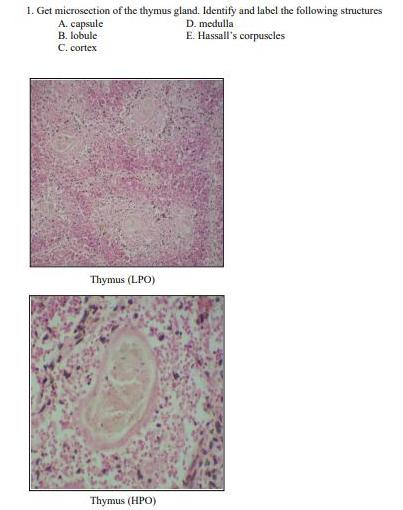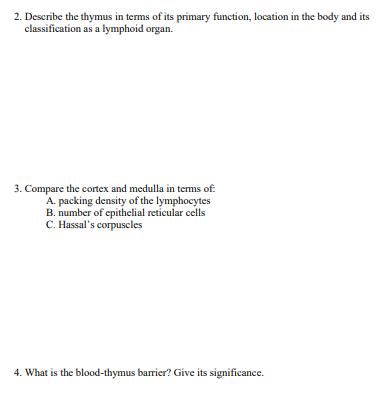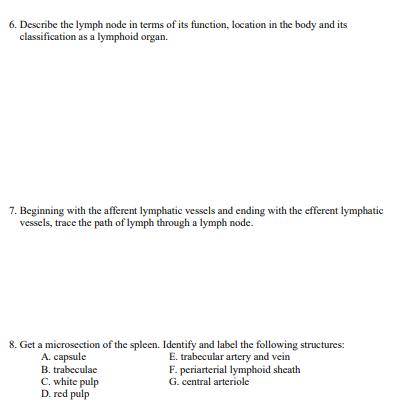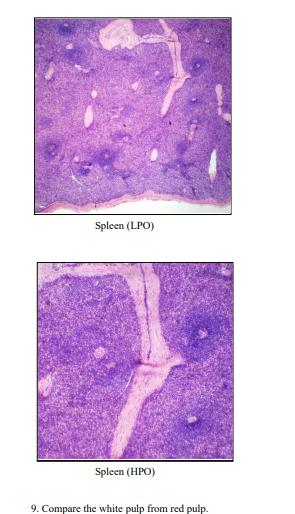Answered step by step
Verified Expert Solution
Question
1 Approved Answer
1. Get microsection of the thymus gland. Identify and label the following structures A. capsule B. lobule C. cortex D. medulla E. Hassall's corpuscles







1. Get microsection of the thymus gland. Identify and label the following structures A. capsule B. lobule C. cortex D. medulla E. Hassall's corpuscles Thymus (LPO) Thymus (HPO) 2. Describe the thymus in terms of its primary function, location in the body and its classification as a lymphoid organ. 3. Compare the cortex and medulla in terms of: A. packing density of the lymphocytes B. number of epithelial reticular cells C. Hassal's corpuscles 4. What is the blood-thymus barrier? Give its significance. 5. Get microsections of a lymph node. Identify and label the following structures: G. medulla A. capsule B. hilum C. trabeculae D. subcapsular sinus E. peritrabecular sinus F. cortex H. lymphoid nodules I. geminal centers J. medullary cords K. medullary sinus L. paracortical zone Lymph Node (LPO) Lymph Node (HPO) 6. Describe the lymph node in terms of its function, location in the body and its classification as a lymphoid organ. 7. Beginning with the afferent lymphatic vessels and ending with the efferent lymphatic vessels, trace the path of lymph through a lymph node. 8. Get a microsection of the spleen. Identify and label the following structures: A. capsule B. trabeculae C. white pulp D. red pulp E. trabecular artery and vein F. periarterial lymphoid sheath G. central arteriole Spleen (LPO) Spleen (HPO) 9. Compare the white pulp from red pulp. 10. Compare the structure of the spleen with that of the thymus gland and lymph node. Note the differences. 11. Name the type, circulation occuring within the spleen and describe cach type of circulation. 12. Get a microsection of the tonsil and label structures that can be identified. Palatine Tonsil (LPO) Palatine Tonsil (HPO) 11. Name the thrce tonsil types in the human mouth and compare them in terms of location, number, crypts and epithelial covering. 12. Where do you find the Waldeyer's ring? Give its significance. 1. Get microsection of the thymus gland. Identify and label the following structures A. capsule B. lobule C. cortex D. medulla E. Hassall's corpuscles Thymus (LPO) Thymus (HPO) 2. Describe the thymus in terms of its primary function, location in the body and its classification as a lymphoid organ. 3. Compare the cortex and medulla in terms of: A. packing density of the lymphocytes B. number of epithelial reticular cells C. Hassal's corpuscles 4. What is the blood-thymus barrier? Give its significance. 5. Get microsections of a lymph node. Identify and label the following structures: G. medulla A. capsule B. hilum C. trabeculae D. subcapsular sinus E. peritrabecular sinus F. cortex H. lymphoid nodules I. geminal centers J. medullary cords K. medullary sinus L. paracortical zone Lymph Node (LPO) Lymph Node (HPO) 6. Describe the lymph node in terms of its function, location in the body and its classification as a lymphoid organ. 7. Beginning with the afferent lymphatic vessels and ending with the efferent lymphatic vessels, trace the path of lymph through a lymph node. 8. Get a microsection of the spleen. Identify and label the following structures: A. capsule B. trabeculae C. white pulp D. red pulp E. trabecular artery and vein F. periarterial lymphoid sheath G. central arteriole Spleen (LPO) Spleen (HPO) 9. Compare the white pulp from red pulp. 10. Compare the structure of the spleen with that of the thymus gland and lymph node. Note the differences. 11. Name the type, circulation occuring within the spleen and describe cach type of circulation. 12. Get a microsection of the tonsil and label structures that can be identified. Palatine Tonsil (LPO) Palatine Tonsil (HPO) 11. Name the thrce tonsil types in the human mouth and compare them in terms of location, number, crypts and epithelial covering. 12. Where do you find the Waldeyer's ring? Give its significance. 1. Get microsection of the thymus gland. Identify and label the following structures A. capsule B. lobule C. cortex D. medulla E. Hassall's corpuscles Thymus (LPO) Thymus (HPO) 2. Describe the thymus in terms of its primary function, location in the body and its classification as a lymphoid organ. 3. Compare the cortex and medulla in terms of: A. packing density of the lymphocytes B. number of epithelial reticular cells C. Hassal's corpuscles 4. What is the blood-thymus barrier? Give its significance. 5. Get microsections of a lymph node. Identify and label the following structures: G. medulla A. capsule B. hilum C. trabeculae D. subcapsular sinus E. peritrabecular sinus F. cortex H. lymphoid nodules I. geminal centers J. medullary cords K. medullary sinus L. paracortical zone Lymph Node (LPO) Lymph Node (HPO) 6. Describe the lymph node in terms of its function, location in the body and its classification as a lymphoid organ. 7. Beginning with the afferent lymphatic vessels and ending with the efferent lymphatic vessels, trace the path of lymph through a lymph node. 8. Get a microsection of the spleen. Identify and label the following structures: A. capsule B. trabeculae C. white pulp D. red pulp E. trabecular artery and vein F. periarterial lymphoid sheath G. central arteriole Spleen (LPO) Spleen (HPO) 9. Compare the white pulp from red pulp. 10. Compare the structure of the spleen with that of the thymus gland and lymph node. Note the differences. 11. Name the type, circulation occuring within the spleen and describe cach type of circulation. 12. Get a microsection of the tonsil and label structures that can be identified. Palatine Tonsil (LPO) Palatine Tonsil (HPO) 11. Name the thrce tonsil types in the human mouth and compare them in terms of location, number, crypts and epithelial covering. 12. Where do you find the Waldeyer's ring? Give its significance. 1. Get microsection of the thymus gland. Identify and label the following structures A. capsule B. lobule C. cortex D. medulla E. Hassall's corpuscles Thymus (LPO) Thymus (HPO) 2. Describe the thymus in terms of its primary function, location in the body and its classification as a lymphoid organ. 3. Compare the cortex and medulla in terms of: A. packing density of the lymphocytes B. number of epithelial reticular cells C. Hassal's corpuscles 4. What is the blood-thymus barrier? Give its significance. 5. Get microsections of a lymph node. Identify and label the following structures: G. medulla A. capsule B. hilum C. trabeculae D. subcapsular sinus E. peritrabecular sinus F. cortex H. lymphoid nodules I. geminal centers J. medullary cords K. medullary sinus L. paracortical zone Lymph Node (LPO) Lymph Node (HPO) 6. Describe the lymph node in terms of its function, location in the body and its classification as a lymphoid organ. 7. Beginning with the afferent lymphatic vessels and ending with the efferent lymphatic vessels, trace the path of lymph through a lymph node. 8. Get a microsection of the spleen. Identify and label the following structures: A. capsule B. trabeculae C. white pulp D. red pulp E. trabecular artery and vein F. periarterial lymphoid sheath G. central arteriole Spleen (LPO) Spleen (HPO) 9. Compare the white pulp from red pulp. 10. Compare the structure of the spleen with that of the thymus gland and lymph node. Note the differences. 11. Name the type, circulation occuring within the spleen and describe cach type of circulation. 12. Get a microsection of the tonsil and label structures that can be identified. Palatine Tonsil (LPO) Palatine Tonsil (HPO) 11. Name the thrce tonsil types in the human mouth and compare them in terms of location, number, crypts and epithelial covering. 12. Where do you find the Waldeyer's ring? Give its significance.
Step by Step Solution
★★★★★
3.48 Rating (171 Votes )
There are 3 Steps involved in it
Step: 1
1 Labelling of parts for Histology of Thymus 2 Functions of Thymus a Stem cells from bone marrow that reach the superficial part of the cortex divide repeatedly to form smaller lymphocytes b Total 90 ...
Get Instant Access to Expert-Tailored Solutions
See step-by-step solutions with expert insights and AI powered tools for academic success
Step: 2

Step: 3

Ace Your Homework with AI
Get the answers you need in no time with our AI-driven, step-by-step assistance
Get Started


